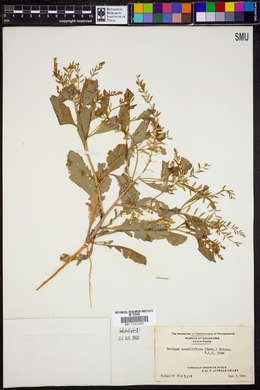Rorippa sessiliflora
|
|
|
|
Family: Brassicaceae
Stalkless Yellowcress
[Nasturtium limosum Nutt.] |
Annuals; glabrous throughout. Stems (simple or several-branched from base) erect, branched distally, (0.9-) 2-4.5(-6.3) dm. Basal leaves not rosulate; blade margins dentate. Cauline leaves shortly petiolate or sessile; blade oblong or oblanceolate to obovate, 1.5-7(-13.3) cm × (5-)10-28(-50) mm, (lateral lobes much smaller than terminal), base auriculate or not, margins dentate or less frequently sinuate, or (lateral lobes) denticulate or entire. Racemes considerably elongated. Fruiting pedicels divaricate-ascending to horizontal, straight, 0.5-2(-4) mm, (slender or stout). Flowers: sepals ascending to spreading, ovate, 1.2-2 × 0.5-0.8 mm; petals absent; median filaments 1-1.6 mm; anthers ovate, 0.2-0.3 mm. Fruits siliques, straight or curved, oblong to oblong-linear, (4-)6-9(-12) × (1.4-)1.8-2.8(-3.5) mm; ovules 158-242 per ovary; style 0.1-0.5 mm. Seeds biseriate, yellow-brown, cordiform, 0.4-0.5 mm, foveolate. 2n = 16. Flowering Mar-Oct. Mud flats, ditches, wet old fields, roadsides, sloughs, fallow fields, floodplains, stream banks, edges of pools, waste grounds, gardens; 0-300 m; Ala., Ark., D.C., Fla., Ga., Ill., Ind., Iowa, Kans., Ky., La., Mass., Miss., Mo., Nebr., N.C., Ohio, Okla., S.C., S.Dak., Tenn., Tex., Va., Wis. Both R. L. Stuckey (1972) and R. C. Rollins (1993) indicated that Rorippa sessiliflora has strongly saccate sepals, but all specimens that I examined failed to show any sign of this character. The species is very distinctive and can easily be distinguished by an absence of petals and by having fruiting pedicels 0.5-2(-4) mm.
Annual herb 20 - 40 cm tall Stem: normally upright, normally branched. Flowers: in branched clusters (racemes). Sepals four, strongly sac-shaped. Petals none. Stamens three to six. Fruit: a thick pod (silique), spreading or ascending, 7 - 10 mm long, often over 2 mm wide. Seeds numerous. Lower leaves: alternate, often pinnately divided below the middle, stalked, oblong- reverse lance-shaped, coarsely toothed. Upper leaves: alternate, stalked, progressively smaller, reverse lance-shaped to egg-shaped, sometimes round-toothed. Similar species: No information at this time. Flowering: late May to early August Habitat and ecology: Occasional in muddy or sandy ground along ponds, rivers, and streams. Also found in other moist areas. Occurence in the Chicago region: native Etymology: Rorippa possibly comes from the Latin roro, meaning "to be moist," and ripa, meaning riverbank. Sessiliflora means "with stalkless flowers." Author: The Morton Arboretum Glabrous annual 2-4 dm, normally erect and branched; lower lvs oblong-oblanceolate, coarsely crenate and often ±pinnatifid below the middle, the upper progressively smaller, petiolate, oblanceolate to ovate, entire to crenate; sep strongly saccate; pet wanting; stamens 3-6; mature pedicels widely divergent, 0.5-2 mm; frs spreading or ascending, thick (often over 2 mm), often slightly falcate, 7-10 mm, with numerous (commonly 150-200) seeds, these tiny (to 0.5 mm), deeply pitted, appearing rough at 10 style to 0.4 mm, or none; 2n=16. Wet soil and shallow water; Fla. to Tex., n. to D.C., O., Ind., s. Minn., and Neb. May-Oct. (Radicula s.) Gleason, Henry A. & Cronquist, Arthur J. 1991. Manual of vascular plants of northeastern United States and adjacent Canada. lxxv + 910 pp. ©The New York Botanical Garden. All rights reserved. Used by permission. From Flora of Indiana (1940) by Charles C. Deam Infrequent but usually frequent to common where it is found. It inhabits muddy places and is often found on the borders of sloughs, ponds, and streams, usually after the water in them has been lowered by dry weather. Also found in low, flat, fallow fields. It is usually frequent on the muddy slopes of the Ohio River and, no doubt, in such a habitat it probably could be found in all of the Ohio River Counties. …… Indiana Coefficient of Conservatism: C = 3 Wetland Indicator Status: OBL |
|
|
|



















































































